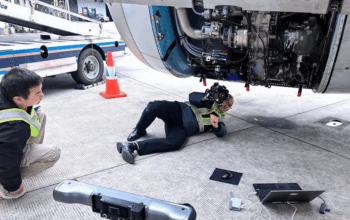3D Scanning Applications in Energy & Heavy Industry
Heavy industry is a type of business that requires a lot of capital, big machinery and is hard to move around. Products like oil, iron, and construction equipment, which are crucial to economic growth and industrialization, used to be produced by heavy industry. Energy and heavy industry have emerged as the foundation for the production of consumer goods as a component of the supply chain for other goods.
Heavy industry machinery manufacturing makes extensive use of cutting-edge 3D measurement technology for everything from product design and optimization to FAI, assembly analysis, quality control, and simulation.
Energy and heavy industry can benefit from automated 3D measurement systems, portable 3D laser scanners, and optical tracking 3D scanners from Scantech. Our precise 3D scanners are portable, making it possible to measure large parts like tractor chassis, excavator arms, wind power hubs, and others right on the spot without having to move them around. To ensure that the components produced meet the stringent requirements, their sophisticated algorithm can provide measurement results with an accuracy of up to 0.02 millimeters.
Scantech is committed to assisting manufacturers in boosting productivity and establishing a competitive advantage in the market. We meet a wide range of energy and heavy industry requirements, particularly:
- 3D Inspection: Scantech 3D measurement technologies truly deliver non-destructive inspections. Compared with contact measurement, 3D laser scanning is much faster and more flexible in capturing full 3D data. The 3D data of complicated curved surfaces, and their coaxial and cylindricity can also be easily obtained, while the traditional solutions are challenging to achieve. However, handheld 3D laser scanners can get complete 3D data without damaging the products
- Reverse Engineering: Scantech industrial handheld 3D scanners can capture high-precision 3D data of objects for the reverse engineering of mechanical products. The accuracy of 3D laser scanners can be up to 0.02 mm to ensure more accurate reverse modeling, which saves development costs and shortens development cycles for machinery manufacturers.
- Maintenance: Mechanical wear is inevitable during the fabrication and application of mechanical products. Even minor errors can cause huge losses, therefore, product maintenance is indispensable. With KSCAN, SIMSCAN, and AXE 3D laser scanners, we can accurately obtain 3D data of mechanical products. This way, we can correctly find the worn parts and better understand how to maintain the products based on 3D data.
NDT Measurement and Inspection for Energy and Heavy Industry
Large sizes, strict GD&T specifications, and constrained machining allowances are common characteristics of the parts used in heavy industries and the energy sector, including parts of farms and construction equipment. A crucial aspect of producing high-quality mechanical parts and ensuring their continued use in good functioning conditions is NDT 3D measurement and inspection.
GD&T Measurement
Pre-production, in-line, and final inspections are the three basic types of quality checks done on items in heavy industry. An essential metric for inspection is geometric dimensioning and tolerancing (GD&T), which guarantees that the parts are certified. Our very accurate 3D scanners can collect accurate measurements of dimensions and tolerances, such as parallelism, perpendicularity, and concentricity, from industrial products. These data can be used to examine newly created items or to fix and improve worn-out components for longer life cycles.
Identifying Machining Allowance
Manufacturers typically add extra material to parts, known as machining allowance, to enable parts to be created to the specified size and accuracy. Determine a reasonable machining allowance for machines with the aid of 3D scanning to lower the percentage of parts that are defective. Engineers are able to precisely determine the machining allowance thanks to the excellent accuracy of our portable 3D scanners like the KSCAN-Magic and optical tracking 3D scanner TrackScan-P. In this manner, quality products can be produced for less money and with less material.
Defect Inspection to Ensure Quality
The manufactured product may include flaws and blemishes, which require inspection and rectification. Traditional inspection is time-consuming and expensive since it mainly relies on the technical expertise of the professionals. Engineers can rapidly and precisely detect unqualified regions with Scantach’s handheld 3D laser scanners since they scan swiftly and measure precisely. It is simple to spot the red and orange unqualified zones. Additionally, it is simple for users to optimize the items appropriately thanks to the abundance of trustworthy data.
Reverse Engineering for Developing Products
By modifying old items to take inspiration from them, reverse engineering might hasten the development of new ones. The point cloud of existing items can be obtained with the use of high-tech 3D scanning for heavy industry and the energy sector. The scanned data can be processed using reverse engineering tools in terms of patch fitting, section construction, and curve extraction to provide CAD models suitable for additional design. It is advantageous for designers to translate their concepts into tangible things and to improve goods so that they more effectively satisfy customer wants.
Surface Inspection of Turbines
The effectiveness and endurance of wind power towers and hydroelectric generators are significantly impacted by turbine inspection. It’s crucial to test vital parts of freshly constructed turbines to make sure they work properly. Regular inspection of the parts is necessary to guard against wear-and-tear damage. Engineers typically use their own eyes, cameras, or drones to visually identify problems, which is laborious. Small spaces can be scanned with portable 3D scanners, which can then be compared to the original designs to find deviations and produce reports for ongoing maintenance.
Click on the following link Metrologically Speaking to read more such blogs about the Metrology Industry.









